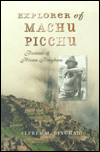 Treasures on Earth
by
Treasures on Earth
by
Machu Picchu (“old pyramid or mountain” in Quechua) is an archaeological site located in the Cusco region, Urubamba province, in Peru. It is often referred to as the "Lost City of the Incas."
The Inca built the royal estate around 1450, but abandoned it a century later at the time of the Spanish conquest. It was brought to international attention in 1911 by the American historian (and later Governor of Connecticut and US Senator) Hiram Bingham. Machu Picchu has since become an important tourist attraction, and perhaps the most familiar icon of Inca civilization. By 1976, thirty percent of Machu Picchu had been restored, and the restoration work continues to this day.
Since the site was not known to the Spanish during their conquest, it is highly significant as a relatively intact cultural site.
Machu Picchu was declared a Peruvian Historical Sanctuary in 1981 and a UNESCO World Heritage Site in 1983. In 2007, Machu Picchu was voted one of the New Seven Wonders of the World in a global Internet poll.
Machu Picchu is vulnerable to threats from a variety of sources. While natural phenomena like earthquakes and weather systems can play havoc with access, the site also suffers from the pressures of modern tourism.
Preservation of the area's cultural and archaeological heritage is an ongoing concern. Most notably, the removal of cultural artifacts by the Bingham expeditions in the early twentieth century gave rise to a long-term dispute between the government of Peru and the custodian of the artifacts, Yale University.
 Explorer of Machu Picchu
by
Explorer of Machu Picchu
by